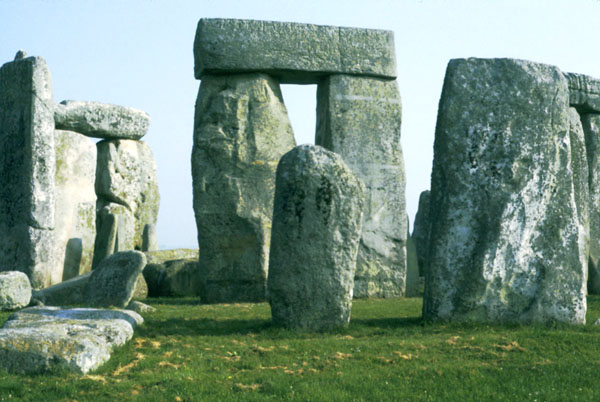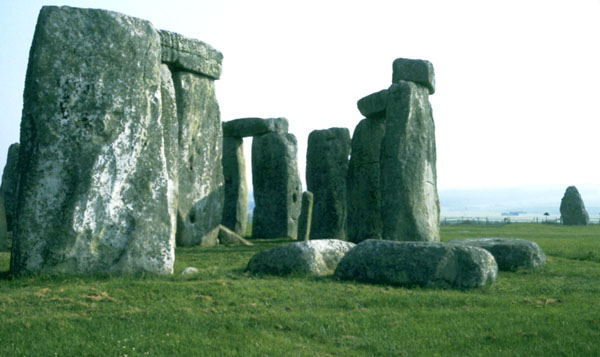
University of California, Irvine
Instructor: Dr. Barbara J. Becker

|
Lecture 2. Taming Human Elements
|
Technological Developments from 10,000 to 3,000 years ago |
| Years, BP | Appearance of.... |
| 10,000 | • permanent settlements
• domestication of plants and animals • refined stone and bone tools |
| 7,000 | • working of native gold, silver, and copper |
| 6,000 | • pottery |
| 5,500 | • complex cities
• writing • wheeled land transport • Egyptian faience • simple metallurgy — copper smelting |
| 5,000 | • Stonehenge started
• bronze |
| 4,500 | • Egyptian pyramids started |
| 4,000 | • glass |
| 3,500 | • small empires |
| 3,000 | • iron
• coastal navigation |
—————————— |
Around 6000 years ago, the southern and eastern parts of Britain were colonized by small groups of farmers from coastal Europe. They made their way across the English Channel and North Sea in skin boats, bringing with them their own seed grain -- a primitive form of wheat -- and small numbers of domesticated beasts -- cattle, sheep, goats and pigs. They settled in a variety of places, but left evidence of their presence in modern day Wessex and the Salisbury Plain in southern England as well as Newgrange in Ireland. Their logging and animal grazing left the land an open plain. Their cultivation depleted the soil. When they moved on, they left behind tools made of flint and the long stone barrows they had built for their dead. More than a thousand years later, new groups of immigrants arrived in Britain from modern day Holland and the Rhineland. They introduced the language known today as Welsh. They brought metalworking knowledge with them, notably copper and gold. They buried their dead singly in mounds and barrows along with a pottery drinking vessel (beaker) and sometimes a copper knife, or bow and arrows tipped with flint. This type of burial is not found anywhere else. Because of their signature pottery, they are known today as the Beaker people. Around 4000 years ago, the Beaker people started making bronze tools and weapons out of copper from the west of Britain and Ireland and tin from Cornwall. They are believed to have played an important role in the construction of Stonehenge. |
——————————
Early Construction Projects

Silbury Hill, Wiltshire — 5600 BP
130ft (41m) high; covers 5 acres
18 million man-hours to build
![]()
![]()

An aerial view of Stonehenge, Wiltshire — 5100-3100 BCE
![]()
![]()
Creation of the circular bank and surrounding ditch (outer diameter ∼ 100 m), positioning of the four station stones (?), the Heel Stone and digging the 56 Aubrey Holes (86.6 m circle).
80 bluestones were transported 240 miles across water and land from Preseli Mountain to Stonehenge.
View from Preseli Mountain, Wales
The bluestones (∼ 4 tons each) were perhaps intended to form a double circle within the large circular earthwork, but only about two-thirds of that task was completed. The erected bluestones were later removed and used again.
The sarsen (dense sandstone) stones were transported 20 miles over land from Avebury to Stonehenge.
The central horseshoe consisted of 10 large upright sarsen stones (each ∼ 30 ft long; ∼ 50 tons). Pairs were topped with a massive lintel to form five trilithons. The outer circle consisted of 30 upright stones (∼ 25 tons each) connected by 30 lintels (∼ 7 tons each).
|

Possible method of raising the sarsen stones.

Possible method of raising the lintels.
![]()
![]()
About 20 bluestones were positioned in an oval arrangement inside the trilithon horseshoe. Holes were dug in two concentric circles outside the large sarsen circle, possibly to place the remaining 60 bluestones.
Finally, the oval-shaped group of 20 bluestones was dismantled and rearranged to form a horseshoe within the horseshoe of trilithons. The remaining 60 bluestones were arranged in a circle inside the outer sarsen ring.
Stonehenge Today
Note the tenon projecting from the top of the sarsen stone on the left. It is the tallest of the stones still standing today. A matching mortise can just barely be seen on its fallen lintel below. Like modern day Lego bricks, the upright stones and their lintels were fashioned to fit securely together.
|

Two of the three remaining central trilithons.
![]()
![]()

The so-called Heelstone can be seen in the distance on the right. An upright bluestone stands in the center of the image. Some of the remaining outer circle of sarsen stones separate the bluestone and the Heelstone.
The central trilithons (including their lintels) are about 20 ft high.
|
|